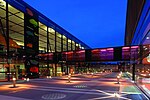Commercial Road

Commercial Road is a street in the London Borough of Tower Hamlets in the East End of London. It is 1.9 miles (3.1 km) long, running from Gardiner's Corner (previously the site of Gardiners department store, and now Aldgate East Underground station), through Stepney to the junction with Burdett Road in Limehouse at which point the route splits into the East India Dock Road and the West India Dock Road. It is an artery connecting the historic City of London with the more recently developed financial district at Canary Wharf, and part of the A13. The road contains several listed buildings. These include the George Tavern, the Troxy cinema, the Limehouse Town Hall, the former Caird and Rayner Ltd works and the Albert Gardens estate.
Excerpt from the Wikipedia article Commercial Road (License: CC BY-SA 3.0, Authors, Images).Commercial Road
Fenton Street, London Whitechapel
Geographical coordinates (GPS) Address Nearby Places Show on map
Geographical coordinates (GPS)
| Latitude | Longitude |
|---|---|
| N 51.514444444444 ° | E -0.058611111111111 ° |
Address
Jennings Bet
Fenton Street
E1 2NE London, Whitechapel
England, United Kingdom
Open on Google Maps






